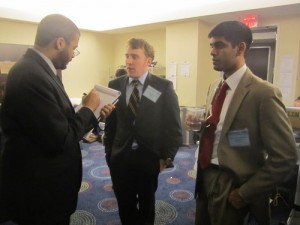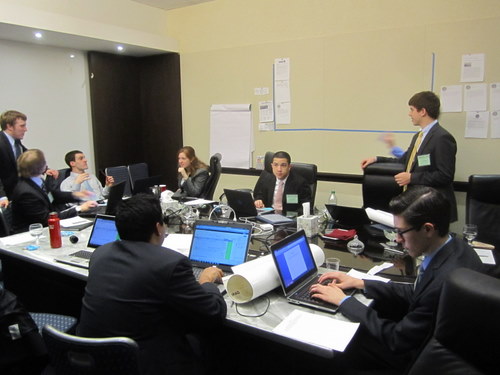
Guest blogger Hayes Brown interviews Arun Avva and Sam Brothers about NAIMUN's new organ, the US National Security Apparatus
This NAIMUN guest liveblog post was written by Hayes Brown, a nine-year Model UN veteran who writes for UN Dispatch and his international affairs blog, At Water’s Edge.
Amr Lehata, Crisis Manager of the Egyptian Interim Cabinet, wears an Egyptian flag pin proudly on his lapel. Talking to him, it’s easy to see that he has a vested interest in his committee, being Egyptian himself, and having culled most of the events the delegates face from the real world events that have swept his country. Starting his delegates off on February 12, 2011, the day after longtime President Hosni Mubarak resigned, the committee and crisis team have worked their way through the linked fate of the Middle East together, as unsure of the results as the protestors in Cairo.
Interconnectivity has become the watchword of the 21st Century. Few events happen in isolation anymore, with events in one corner of the world rippling throughout the region and across the globe. NAIMUN has taken two tacks to approach this new linked nature of world events, through the events of today and of ten years ago.
The Arab Spring highlighted the effects of this growing bond between disparate areas, as protests spread as a wave across the Middle East and North Africa over the past year. Several committees at NAIMUN are harnessing that spirit, including the Egyptian Interim Cabinet and a joint crisis between the Saudi Arabian and Iranian Cabinets, all centered on the complexities of protest and revolt.

The events and consequences of the Arab Spring were a theme throughout many of NAIMUN's crisis committees.
The delegates got quite an example last night, Amr informed me, as an idea he had in the back of his mind for a long time came to fruition. Several weeks ago, the Crisis Managers of the Joint Iranian-Saudi Cabinet crisis, the Egyptian Interim Cabinet, and League of Arab States came together to plot out a way to have their four committees interact. It was decided that the three of them would ensure that their committees would end on roughly the same “date” within their crises at the end of the last session on Friday. Then the fun would begin.
The four committees were called into a midnight session, with the crisis lurching to the events in Syria. In theory, according to Amr, the Cabinets would interact with their Ambassadors to the League, often delegates from other schools who had never interacted before, and the League would come to a decision. To the surprise of the Managers, the committees began interacting between themselves as well, Cabinet to Cabinet in an attempt to forge an accord.
This lined up well with Amr’s philosophy in developing crises. The Managers went with the flow, collaborated, and ensured that a solution would be found, despite it being, as he put it, “a logistical nightmare”. The styles of the three managers all luckily meshed, following the same disdain for strict crisis trees, preferring a more free-flowing creation of events. As Amr said, “if you know a situation, you can react to it”, making clear the large amounts of preparation that need to occur to make this style of crisis-planning work.

The crisis staff had to work well together in order to pull off the conference's numerous crisis simulations.
Amr isn’t alone in this thinking. The second tack shows the way that governments themselves have grown more interconnected as reaction times reduce to near instantaneous. The United States National Security Apparatus is a collection of five “concurrent” crises. While not fully integrated in the style of a joint crisis, the committees exist within the same “universe” and are made aware of the decisions that their counterparts come to, which in turn affect their own choices.
Speaking to Arun Avva and Samuel Brothers, the Undersecretary-General and Deputy Undersecretary-General respectively of the US National Security Apparatus, it’s clear that the learning at Model UN conferences is never one way. “When I first thought of this concept,” Arun told me, “I thought the committees would interact far less than they wound up doing.” The United States decision-making when it comes to national security is even more linked than he’d anticipated; rather than compartmentalizing issues and seeing them only from their own bodies perspective, they considered the views and actions of all the other bodies.

NAIMUN featured a new organ, the US National Security Apparatus, which simulated different committees that make decisions about American foreign policy and national security.
Luckily, the Georgetown staffers were well prepared to think on their feet. Arun and Sam informed me that Crisis Managers, particularly in this organ, are taught to eschew the rigid structure of crisis trees, and instead have broad “arcs” to their plans, reminiscent of seasons of television shows. While the general plot of the committee’s events are decided, many of the details are left to the delegate’s reactions, with the student’s reactions potentially affecting the bend of the arc. In particular, as the committees take place in 2002, in the shadow of the 2001 terrorist attacks, the arcs dealt with pitting the United States against Iran and a deteriorating situation in the Middle East.
The US National Security Apparatus managed to luck out when it comes to its managers, according to the two Senior Staffers. The five bring to the table their experience in travelling and in taking classes on the subject matter. They also acknowledge that there can be an “X Factor” in running crises, an innate ability that some people possess to create scenarios that challenge and excite delegates. Arun and Sam, and the other USGs on staff, attempt to harness these various factors, working directly with their Crisis Managers on their ideas for their committees and how best to implement them.
The key to ensuring this endeavor works, Sam said, is having everyone in the same room and on the same page. The crisis teams all post the updates and handouts on a joint wall, labeling the times the delegates receive them, and are constantly shouting out minor details to each other to keep everyone in the loop. The communication among the staffers shows in their output and is reflected back by all of the committees. From the streets of Cairo to halls of power in Washington, D.C., the ties that bind people together are tightening, and NAIMUN is making sure delegates never forget it.


